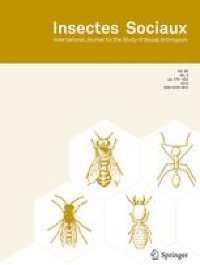Laboratory studies on insects face the dual challenge of maintaining organisms under artificial conditions, and in reduced spaces while mimicking the species’ ecological requirements as much as possible. Over decades, myrmecologists have developed and continuously improved laboratory methods and artificial nests for rearing ants. However, the setups commonly used to house colony fragments of few individuals or even isolated individuals present disadvantages such as insufficient ventilation, difficult access to specific workers, and problems with water delivery. Here, we developed and tested a new setup for keeping ants or similar sized insects in small groups. The setup consisted of a Petri dish containing a piece of plaster connected underneath to a water tank by a sponge. The sponge is immersed in the water on one side and embedded in the plaster on the other side, maintaining the plaster permanently moist and thus offering a water source to the ants. We tested the setup with two ant species of different sizes, Platythyrea punctata and Cardiocondyla obscurior in feeding, starvation, and desiccation conditions. Our results showed that our new setup worked equally well for both species in all conditions in comparison to a more conventional setup with the advantage of reducing maintenance costs and ant manipulation, but also preventing death by drowning and offering water ad libitum. The setup was quick to build, with cheap and reusable materials for further experiments. Therefore, we are confident that it will facilitate future studies on isolated or small groups of individuals and that such a standardized setup will make future studies more comparable.




Very interesting. I might try to copy the water part next time I want to DIY a formicarium, then I can just fill a tub when it is low instead of swapping out test tubes and stuff.
also, would this community be ok with talking about hobby ant keeping as well? or should I find another one?